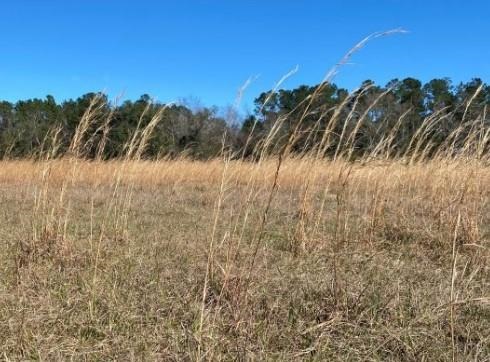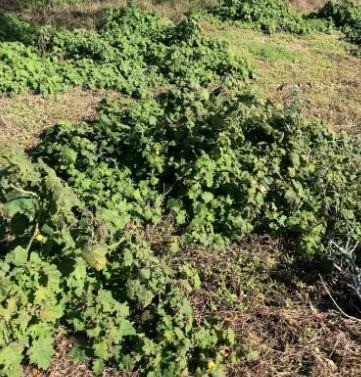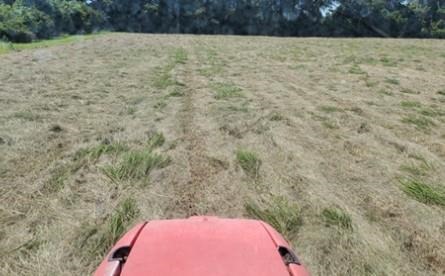By Robbie Jones
Broomsedge infestation in a bahiagrass pasture. Credit: Robbie Jones, UF/IFAS

A theme I have seen this past year is pasture weeds becoming a major nuisance for landowners and cattlemen. Weeds don’t just reach a threshold overnight, there is a time we can make an impact without breaking the farm budget. However, many times pasture weeds have reached a point that control takes a considerable investment of time and money before any action is taken. In the world of forage and cattle production profit margins are razor thin, so controlling weeds early, to keep control costs low, is important.
First and foremost, knowing your soil chemistry is important for weed control. Keeping your soil fertility up can aid in helping the forage crop be healthy and grow vigorously. A healthy forage stand can shade out seedling weeds before they are able to get established in the field. When forages are stressed and not growing to their potential, it is easier for weeds to emerge and spread. Keeping your field’s soil chemistry at peak level will go a long way towards preventing weed problems.

Tropical soda apple on the edge of pasture.
Another long-term management strategy is to do a good job scouting your pastures and hay fields. However, don’t just watch the field itself. Those weeds are coming from somewhere, and many times this is from right-of-ways or neighboring land. Keep a watch around the barrier of your field. If you see a problem, address the weed then. It is much easier to address a weed that is young than mature weed. Usually, a targeted spraying of a small area can prevent further spread. However, you need to make sure that is done quickly when the weed is immature and has not yet produced seed. The problem with weeds is they reproduce vigorously, so if you let them get established and start spreading, before managing them, it will take more time and effort to get them under control.
Know the times of the year weeds are germinating and look for them. For example, winter weeds are germinating and emerging November through February, so this is when you should be scouting for your winter weeds. Knowing when to look and where to look will help you keep the weeds under control. When you allow weeds to flower and make seed, a soil seed-bank becomes established, and that seed bank can last a long time. For example, in Gadsden County when they have torn down old shade tobacco barns, crotalaria has sprouted up from seeds that have been dormant in the ground for decades. All at once the soil is disturbed and light and moisture reach the dormant seeds and they immediately start sprouting up. The longer you wait to address a weed situation, the more the seed bank develops. This is how weeds survive, as they don’t all germinate at the same time.
Hay and seed selection are another strategy for prevention of weeds. Buying hay from producers with clean fields is important. During the year when farmers and ranchersrely on hay, hay that is filled with other weed seeds can be a point source of spreading weeds into pastures. Sometimes you can quickly find weeds in the spring growing around areas where hay was fed in the field. It is advisable to always get hay from producers you know do not have weed problems. You also need to make sure you are not baling your own fields with weeds and then spreading that to other fields as you feed hay. When you purchase seed for annual forages or for pasture establishment of perennial varieties, it is important to get certified seed. These seeds will come with an assurance that they are the variety you want. Getting uncertified seed could lead to you getting less desirable or undesirable forages or weeds instead of what your thought you were purchasing.

Dogfennel in a bahiagrass pasture when cutting for hay. Credit: Marcelo Wallau, UF/IFAS
Typically weed infestations are past these preventative management strategies and require immediate action, because they have passed a threshold and have become a major problem. At this point rapid, effective control is needed. It is always advisable to get proper identification of the weed(s) you are dealing with, so you can find the most effective control method to use. An easy way of identifying the weed is working with your local UF/IFAS Extension Agent. If your local agent is unable to identify a weed, a sample can be sent to the UF Herbarium in Gainesville, for identification. Once the specific weeds are identified, your agent can work with state specialists to help develop the best plan to address the weed problems. Herbicide selection and timing are key parts of successful control plans, so don’t wait for infestations to get out of hand.
Overall, proper advance strategies of prevention and monitoring for an integrated pest management plan (IPM) can make an impact on the cost of pasture maintenance. In the world of thin profit margins for forage and livestock production, cutting cost for pasture management can be end up costing more in the long run. An ounce of prevention can be better than the pound of cureon your farm budget.
Source : ufl.edu